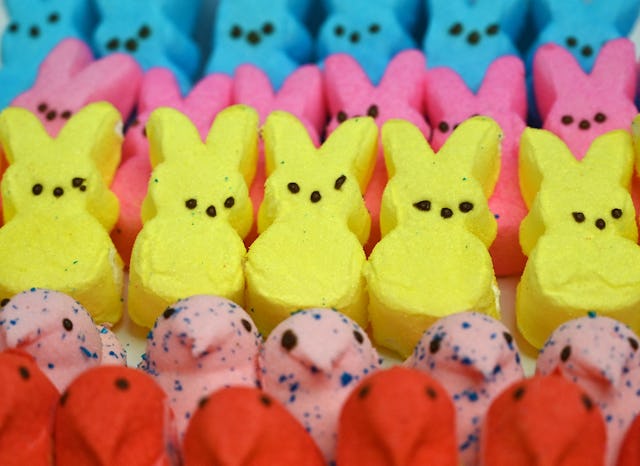Consumer Reports Warns That Some Peeps Contain A Cancer-Causing Dye
Advocacy groups are calling on the iconic Easter candy’s company to remove the ingredient.

You don’t need to be a food scientist to know that marshmallow Peeps Easter candy isn’t the best thing to eat. However — since the iconic sugarcoated marshmallow treat shaped like birds and bunnies only comes around once a year — eating them or adding a pack to your kid’s Easter basket doesn’t seem like that big of a deal.
However, a consumer advocacy group is calling out the maker of the popular Easter treats because some versions of Peeps, like pink and purple variations, contain a cancer-causing ingredient.
Known carcinogen Red Dye No. 3 is said to be an ingredient in certain versions of Peeps, according to Consumer Reports.
While the Food and Drug Administration (FDA) currently allows the use of the dye in food and ingested drugs, studies have shown that in very high doses, the dye can cause cancer in animals. Over 30 years ago, the FDA banned the use of Red Dye No. 3 in cosmetics and external drugs, though they said that the actual risk of getting cancer from the dye was very small, according to The New York Times.
“Parents should know that the purple and pink colored Peeps they may be putting in their kids' Easter basket are made with an ingredient that is a known carcinogen,” Michael Hansen, senior staff scientist for Consumer Reports, said in a statement. “Just Born Quality Confections should stop making its iconic marshmallow treats with this dangerous food chemical since other less risky alternatives are readily available.”
According to Consumer Reports, Just Born Quality Confections uses Red Dye No. 3 in a range of Peeps including: Peeps Pink Marshmallow Chicks, Peeps Pink Marshmallow Bunnies, Peeps Lavender Marshmallow Chicks, Peeps Lavender Marshmallow Bunnies, and Peeps Hot Tamales Marshmallow Chicks.
Consumer Reports has started a petition that has already received more than 16,000 signatures. The petition came after previous attempts to reach out to the Peeps manufacturer to stop using the dye earlier this year failed. Consumer Reports claims Just Born Quality Confections has not announced any plans to change its manufacturing process.
In a statement responding to Consumer Reports, Just Born reiterated that Red Dye No. 3 is currently approved by the FDA for use in candy. They also mentioned their product development team is exploring other options from “natural sources” for coloring their candy.
“We manufacture all our candies in compliance with FDA regulations, sourcing our ingredients and packaging exclusively from reputable suppliers who adhere to high quality and safety standards. We also provide consumers with information on our packaging and our websites to help them make informed choices about our products,” the statement said.
“Our product development team is continually exploring opportunities to provide expanded options for our consumers, including colors derived from natural sources that can deliver the same visual impact and stability as their certified counterparts.”
Though there is no solid evidence that Red Dye No. 3 causes cancer in humans, there are several anecdotal instances from parents who notice changes in their children’s demeanor when consuming the dye.
Father of three, Matt Parks, told Yahoo Life that he and his wife do all they can to restrict their daughter from eating anything with Red Dye No. 3. “We very strictly limit the amount of red dye that our kids have," he says, noting that they're especially cautious with their younger daughter.
“We have noticed that when she has red food dye, her ability to regulate emotions becomes impaired,” he says. “She's very easily agitated and upset — far more than normal. It's gotten to the point where even she notices the change.” Parks told the outlet that he has ADHD and notices that, when he has products with Red Dye No. 3, he feels more irritable and agitated.
“It's not a cause of those symptoms, but it does seem to be a trigger,” he says.
Carrie Conrad, a mother of three, told Yahoo Life that her kids only have red food dye once or twice times a year, but “every time we do, we regret it.”
“My kids lose control over themselves,” she says. “There's screaming, running, rebelling. The kids are unable to connect or register any safety rules. It's pure chaos.”
The chemical has been linked to behavioral issues in kids. Though evidence is limited and only shows an association between the dye and a child’s behavior. There is still no concrete evidence that Red Due No. 3 actually causes certain health issues or behaviors.
However, it’s important to note that some health professionals believe that while there is no solid proof the dye causes harm, there’s also no proof it has any sort of benefits. “Red dye offers no nutritional or positive impacts on health,” Jamie Alan, an associate professor of pharmacology and toxicology at Michigan State University, told Yahoo Life. “There is only potential harm, although the jury is out on the amount of type of harm it may or may not cause.”
California lawmakers have even introduced a first-of-its-kind bill that would ban the synthetic food coloring. If the bill passes, items like fruit cups, chewy candies, Skittles and Peeps would need to change their ingredients to be sold in that state.